Basketball Weak Side Defense & How To Establish Good Help Positioning
Weak side defensive positioning is one of the most important concepts to teach. If not approached properly, it can also be one of the most difficult.
Simply put, good help positioning solves LOTS of problems for you...
It makes your team appear quicker because they have less ground to cover. For example, if your players are positioned properly, they can quickly close out to the players they are guarding or they can step in to help.
Good positioning is something you must maintain throughout the entire possession.
Why do you think most good offensive coaches preach ball reversals? This is because they want to reverse the ball a bunch of times so your players will eventually get out of position and they can expose the seams in your defense.
The great thing about positioning is that even slow players can get good at it. Positioning is more of a mentality and a habit than a physical ability. Even a non-athletic player can learn great positioning.
How Do You Quickly and Easily Teach Help Positioning?
As a coach, you will never have enough time to cover all the different situations your players will face. That's why we set rules that apply to all situations.
It's very important for you to do the same so that your players understand what to do when faced with unique situations. Here's an example of ours below:
VERY IMPORTANT WEAK SIDE DEFENSE RULES!!
When defending the player away from the ball:
Stay between your man and the ball. See your man and the ball at ALL times!
Deny all penetrating passes.
Be close enough to stop the player you are guarding if the ball is passed to him.
Be close enough to help! You should be close enough to the player with the ball to prevent him from getting into the danger zone if he dribbles by the defender that is guarding him.
Always stop the ball if it is in front of you!
It doesn't matter if the player with the ball is at half court, high post, corner, etc. You should always be in position to stop your man and stop penetration.
Here are some scenarios to help you understand these rules...
FREE BONUS PDF
The Best 11 Defense Drills
How to Defend the Perimeter Pass (One Pass Away)
One Pass Away refers to when you're guarding an offensive player and there are no other offensive players between you and the ball.
When the ball is one pass away, your positioning is very important because this will determine whether you can help on the dribble drive or rotate if needed.
When One Pass Away:
Be Close Enough to Help - When a player is one pass away, the defensive player should be off the player he is guarding and both "Up the Line" and "On the Line."
Up the Line - The line we are referring to is the imaginary line between the player with the ball and the player that the defender is guarding.
The defender should be a 1/3 to 1/2 the distance up that imaginary line. This distance allows the defender to be close enough to help on dribble penetration. It also allows him to be close enough to stop the player he's defending if the ball is passed to him.
If the ball handler gets by the defender and you cannot get there in time to help, you are probably not far enough "Up the Line."
On the Line - This refers to when the defender should have his feet or hands in the path of that imaginary line. This positioning may vary depending on whether you allow or deny the perimeter pass.If you allow the perimeter pass, you may take a step back so you can stop penetration. If you deny it, you'll definitely want to have a foot and hand on the imaginary line to force more turnovers.
Be Close Enough to Stop the Player You Are Guarding - You want to be close enough to help, but you also need to be close enough to stop the player you're guarding if the ball is passed to him. If you cannot get to your player in time to stop him, you are probably too far "Up the Line."
Be Ready to Move - Just like any other position on the court, you must have your knees bent and ready to move quickly!
See Man and the Ball - You should be able to see the man you are guarding and the player with the ball at all times. This way you can see if your man moves. You can also react to help on dribble penetration if the ball handler penetrates.
Head Position
Something that is crucial while seeing your man and the ball is head position.
When you're one pass away, you always need to see your man and the ball at all times, so head position is really important. Your head should essentially be looking straight between the ball and your player so that you never have to turn it.
If you have to turn your head to see the ball, or if you have to turn your head to see the player you're guarding, you're in the wrong position. It's very important to see both the man and the ball without turning your head.
A big mistake that most players make is that they're constantly looking back and forth. If you have to look towards the ball for a split second, your man can cut behind you and beat you for a lay-up to the basket. If you take your eye off the ball to look at the player you're guarding, the offensive player might dribble-penetrate by the defender and you'll be too late to help or rotate.
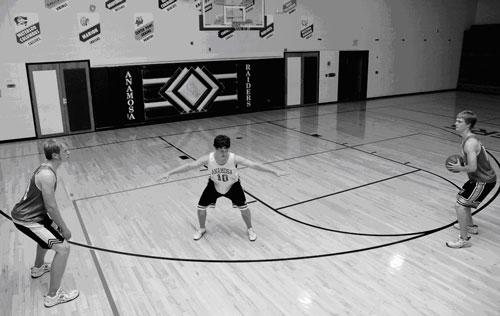
One Pass Away - Deny versus Contest (Allow)
When defending the ball one pass away, you can either "Deny" the perimeter pass or "Contest", or allow the perimeter pass.
Deny the Perimeter Pass:
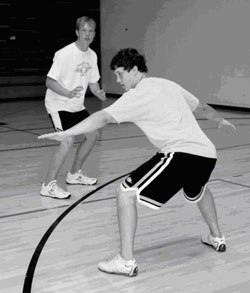 If you've got a really quick team and you're going to rely on causing a lot of turnovers, you may want to position your perimeter players in the passing lane to deny the pass.
If you've got a really quick team and you're going to rely on causing a lot of turnovers, you may want to position your perimeter players in the passing lane to deny the pass.
Pros:
When your players are denying the wing, the opposing players won't be able to catch the ball, and this can cause turnovers, such as 5-second calls and bad passes. It could also force the offensive player to over dribble and destroy the offensive rhythm. Notice, the player in the picture is "On the Line."
Cons:
Although, you can create more turnovers, you will be more susceptible to dribble penetration because you have more distance to cover when trying to help from a closed, denial position.
Contest the Perimeter Pass:
 The other option is to contest the pass, which allows the perimeter pass. This focuses more on defensive help positioning rather than going for the steal. Even though the focus isn't on stealing the pass, if you have a guaranteed steal, you'd better go for it.
The other option is to contest the pass, which allows the perimeter pass. This focuses more on defensive help positioning rather than going for the steal. Even though the focus isn't on stealing the pass, if you have a guaranteed steal, you'd better go for it.
With this tactic, you step back a little bit so you're in better position to help, and you're allowing the perimeter pass to go through.
Even though, you allow the perimeter pass, you can also deny all penetrating passes. These are passes inside the 3-point line.
Although your defense is allowing the pass to go around the perimeter, ball pressure is still needed. Typically, when we contest the pass, we use an open stance (mentioned later) as well.
Pros:
This is a good defensive tactic because it can make it hard to get the ball close to the basket. You also force low percentage shots because it's easier to contest shots since you are in good defensive position.
Cons:
There is not much pressure beyond the 3-point line, so you might not force as many turnovers. Also, you may not mentally wear down the opponents as much as you can with a pressure defense that denies passes.
Wolf Pack Defense - Like Packline
This type of defense is also what we refer to as a "Wolf Pack" style defense. If a predator penetrates the wolf's boundaries, the wolf pack swarms them. Your defense should act in the exact same manner.
If the ball handler penetrates, the defender nearest to the ball should swarm to the ball and make him pick up his dribble or pass the ball. If the offense gets the ball near the "Danger Zone," your defense needs to swarm the ball handler and force him to turnover the ball or pass the ball away from the basket, which would result in a lower percentage shot.
Some other coaches might call this "Saggy" defense. We really dislike this terminology because it gives kids the perception that it's a lazy and relaxed type of defense compared to the denial defense when, in reality, this is completely untrue.
Just like a denial defense, you should be intense, always on the balls of your feet, and constantly communicating. The only difference is that you allow the pass around the perimeter.
If you use the "Wolf Pack" terminology, it brings a tenacious, intense mentality to playing this type of defense, which is exactly what you want from your players.
Here are a few more pictures that give you a different viewpoint of "Denying" versus "Contesting":
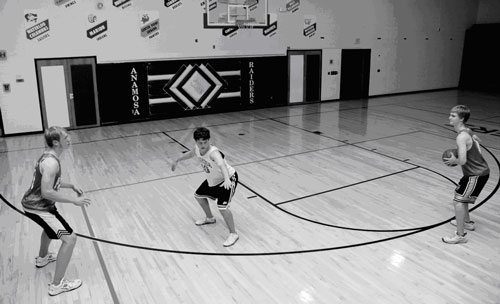
Contesting the Pass:
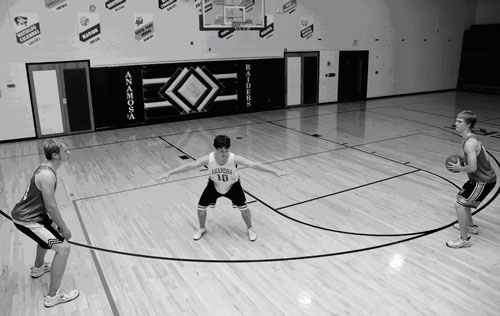
Defending the Perimeter Pass (Two Passes Away)
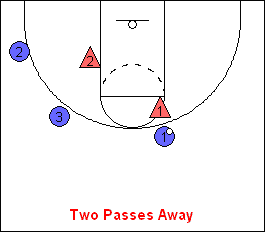
Two Passes Away refers to when you're guarding an offensive player and there are one or more offensive players between you and the ball. It's very important to be positioned properly to help out on dribble penetration or to rotate.
In this diagram, Player 2 is guarding the player in the corner.
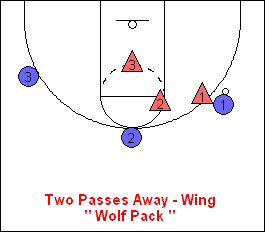
When the ball is on the wing and you're two passes away, we always teach for at least one foot to be on the rim line.
The rim line is the imaginary line going down the middle of the court from basketball hoop to basketball hoop.
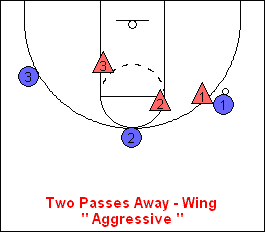
With a more aggressive defense where you are pressuring the ball and denying passes, you may want to use the one-foot-in-the-lane technique. This will enable you to steal more skip passes. At the same time, it'll make you more susceptible to penetration.
When we played pressure defense, we still used the rim line concept mentioned above.
If you're playing a "Wolf Pack" style defense to prevent players from reaching the "Danger Zone", it's better to get your players on the rim line.
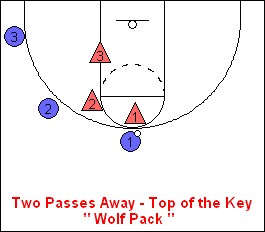
When the ball is on the top of the key, the player two passes away does not have to be on the rim line. Rather, just next to the lane or with one foot in the lane.
This is important because you need to be in the lane to help and stop any penetration to keep the ball out of the lane.

If you're playing an aggressive defense where you are trying to force turnovers, you may want your defensive player to be a couple steps closer to the offensive player they are defending.
How Do You Teach Your Players Weak Side Help Positioning?
One of the best ways to teach help side positioning is to run Shell Drills and Over Load drills. Coach Jim Huber demonstrates a couple of examples below.
Shell Drill
4 on 4 With Baseline Drivers
Beyond that, if you want more in-depth information, our man to man defense video with Jim Huber shows you step-by-step exactly how to teach good help positioning.
The video also includes dozens of defense drills and all the key aspects of a tough man to man defense.
FREE BONUS PDF
The Best 11 Defense Drills
|
|||||||||||||||||||||||||||||||||||||||||||||||||||||||||||||||||



 Facebook (145k Followers)
Facebook (145k Followers) YouTube (152k Subscribers)
YouTube (152k Subscribers) Twitter (33k Followers)
Twitter (33k Followers) Q&A Forum
Q&A Forum Podcasts
Podcasts